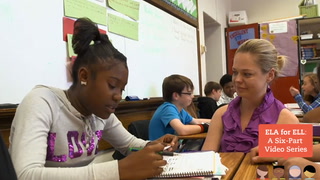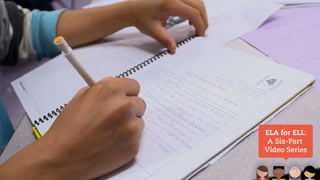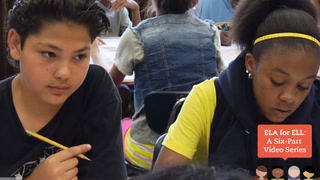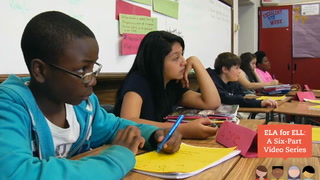Persuasion Across Time & Space: Unit Overview Final Program Transcript
Katie Langlois: We’re going to move now into another section of the unit about persuasion.
Emily Park-Friend: Raul can you read our goal for today please?
Aida Walqui: The unit is called ‘Persuasion Across Time and Space’ analyzing and producing complex texts. The unit runs around the nature of texts that intend to persuade audiences about specific ideas or issues.
George Bunch: The unit was developed to provide an exemplar for teachers and others to begin to re-think how instruction for English learners might be planned and enacted in order for English learners to have the maximum opportunities to meet the Common Core Standards.
Emily Park-Friend: The second question, can you read that for me Effrain?
Student: Were you able to convince the other person you were arguing with about anything?
Emily Park-Friend: What’s convince mean?
Student: To persuade.
George Bunch: It’s really essential to understand that the unit that we are talking about today was developed for English learners at least at the intermediate level of English language proficiencies. This unit was not developed beginning level English learners, brand newcomers. So students at the intermediate level in a unit that provides sufficient support not only are able to engage with their mainstream peers, their native English speaking peers, or students with a greater level of English language proficiency than they have. But those students also provide an important source of models for different ways to carry out conversations for ways to engage with texts. So it’s important for English learners to engage with students from a variety of backgrounds in order to engage in activities around complex texts. So the Common Core Standards call upon all students to engage in language and literacy activities that focus on disciplinary practices at the heart of various content areas. So in English Language Arts the Common Core Standards call on students to engage in texts of increasing complexity. To use writing for building arguments in relation with complex texts, to use speaking and listening skills to engage in debates, to talk about important ideas, to build knowledge together with other students, to present that knowledge to an audience, to discuss that knowledge in small groups, an to use language in meaningful and creative ways.
(student/teacher table discussion)
student: He said that he wants people to take action against Civil Rights and then we’re going to use the quote where he says
George Bunch: So this creates challenges for all students. For English learners there are obviously additional challenges because English learners are going to be engaging in these practices in a language that they’re still in the process of developing.
Emily Park-Friend: In your group of four decide who’s going to go first and your going to share out your partners story. We’re not commenting on the stories until everyone has shared.
Student: One memorable argument that Raul has had he was they were arguing if he should go to the baseball practice or not.
George Bunch: The challenges are also opportunities because the kinds of challenges presented in the Common Core with appropriate support can be the very kinds of language learning opportunities that English learners need to be able to engage in increasingly interesting and meaningful and important and challenging discourse.
Aida Walqui: We have crafted a whole system of scaffolds or supports throughout the unit. Scaffolding is the temporary support that is offered students so that they can work beyond their current level of autonomy. But scaffolding has precisely as its goal the fostering of student autonomy because it’s providing supports only while those supports are needed. And these supports are sometimes supports that are academic, conceptual, linguistic but they’re always woven together.
Katie Langlois: Every group is going to read just one speech and then go back to your home group and you’re going to report on that speech. So if you look in your book there’s background reading for each of these speeches. So if you’re reading the Wallace speech you read background on the Wallace speech.
George Bunch: The language learning opportunities are embedded in the rich and meaningful instruction, with specific focus in many places on language and literacy but not separated from the kinds of activities and practices called for by the Common Core Standards. So we’re not talking about removing English learners from the challenges of the Standards but rather finding ways to support them in meeting them.
(graphic)
Aida Walqui: The unit has five lessons. Each lesson is intended to last one week. So the unit begins with an exploration of advertising in the contemporary world.
George Bunch: The language of advertisements is something students are often very familiar with. And they’re familiar with now multi-modal ways of communicating, often more so than their teachers are. So we start with a place where students are more familiar and move onto less familiar kinds of texts.
(graphic)
Aida Walqui: Lesson two goes into the Gettysburg Address
George Bunch: We focus on speeches because speeches often include very rich language; they include opportunities to think and talk and learn both about historical issues and contemporary issues.
Katie Langlois: Why was Lincoln there at the field that day? What was his purpose?
Student: Wasn’t it like to open the first cemetery?
Aida Walqui: The main goal of that lesson is to help teachers understand the importance of building background understandings but also to help students recognize how things begin, unpack and end, right? We have a sense of every text doing something and how it’s done in a speech, but also how specific words and the repetition for example of specific words confer importance to key ideas.
Katie Langlois: Does anyone remember of the top of their head that uses the word ‘Proposition’? You think you have it Alexis?
Student: Is it like the proposition that all men are created equal or something?
Katie Langlois: Yes. Exactly.
(graphic)
Aida Walqui: Lesson three looks at the three appeals that a persuasive text usually presents. So we look at Logos – how the logic in the argument is constructed. We look at Pathos – the textural elements that bring emotion to a text. And Ethos, which is an appeal to the authority that the author presents but also to the ethical sense of the reader or listener.
Student: Logos is having reason and logic to persuade, so it’s more like facts. So like maybe a campaign commercial for a President?
(graphic)
Aida Walqui: In lesson four we hone in to the very specific language that signals the overall discourse structure of speeches but also very potently at the word choices and how word choices do make a difference in a text.
Emily Park-Friend: What’s the first sentence?
Student: When I look at race relations today I see some positive changes have come about.
Emily Park-Friend: So it sounds like she’s starting to talk about today
(graphic)
Aida Walqui: And then finally in lesson five we build on the multiple connections that students have been making about everything they’re learning about persuasive texts so that they use it to create their own speeches and then critique their peers work. Each lesson comes in three important moments: the first moment we call ‘preparing learners’. When we are preparing to face a text we either want to activate prior knowledge that the learners have or we want to build background knowledge – for example with the Gettysburg Address. Then you bring the text and you help students interact with the text. So there are a number of activities that for example pick out a chunk of the text, help them de-construct that chunk, and then re-connect it back to what is the logic that is being followed in the text.
Emily Park-Friend: I’m going to give each of you a little section of this speech, ok? You in your group are going to try to put it back in order.
Aida Walqui: The third moment is called ‘Extending Understanding’. So by now students have understood what the text is about but they need to take that universe that they have learned and connect it to other ideas they have been developing or connect them to the world or other situations.
Emily Park-Friend: Please stick your piece of paper in your yellow book because we’ll re-visit this tomorrow, ok?
Aida Walqui: The objective of the unit is to provide a model for how we can engage students and we feel very happy that teachers who worked with us in a pre-pilot and the pilot are all really delighted and that many of them were surprised that English learners could talk so much and that they could work with such difficult texts and that’s exactly the kind of surprise we want our teachers to get, but more importantly the assurance that this is the case and that that can only be done if we only understand the nature of learning which is the ability to participate in activity beyond our autonomy level and the importance of nourishing student voice and agency.
- END -















10 Comments
Sandra Hemphill Mar 20, 2018 1:05pm
Beth Harmon Jul 31, 2016 5:28pm
robin taylor Sep 15, 2015 7:01pm
Susan Keiffer May 16, 2015 1:38pm
Pam Nicholls Mar 8, 2014 7:07pm